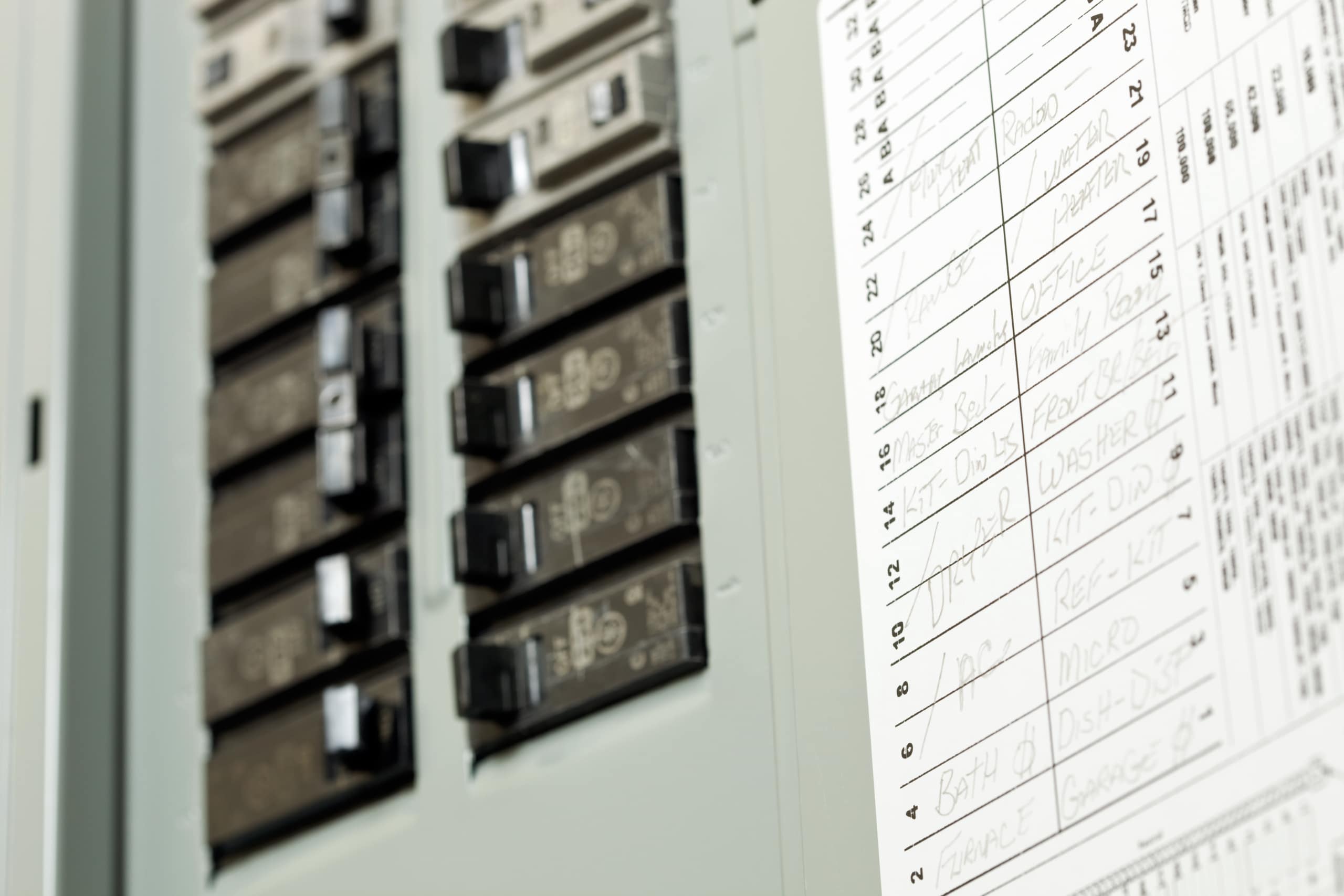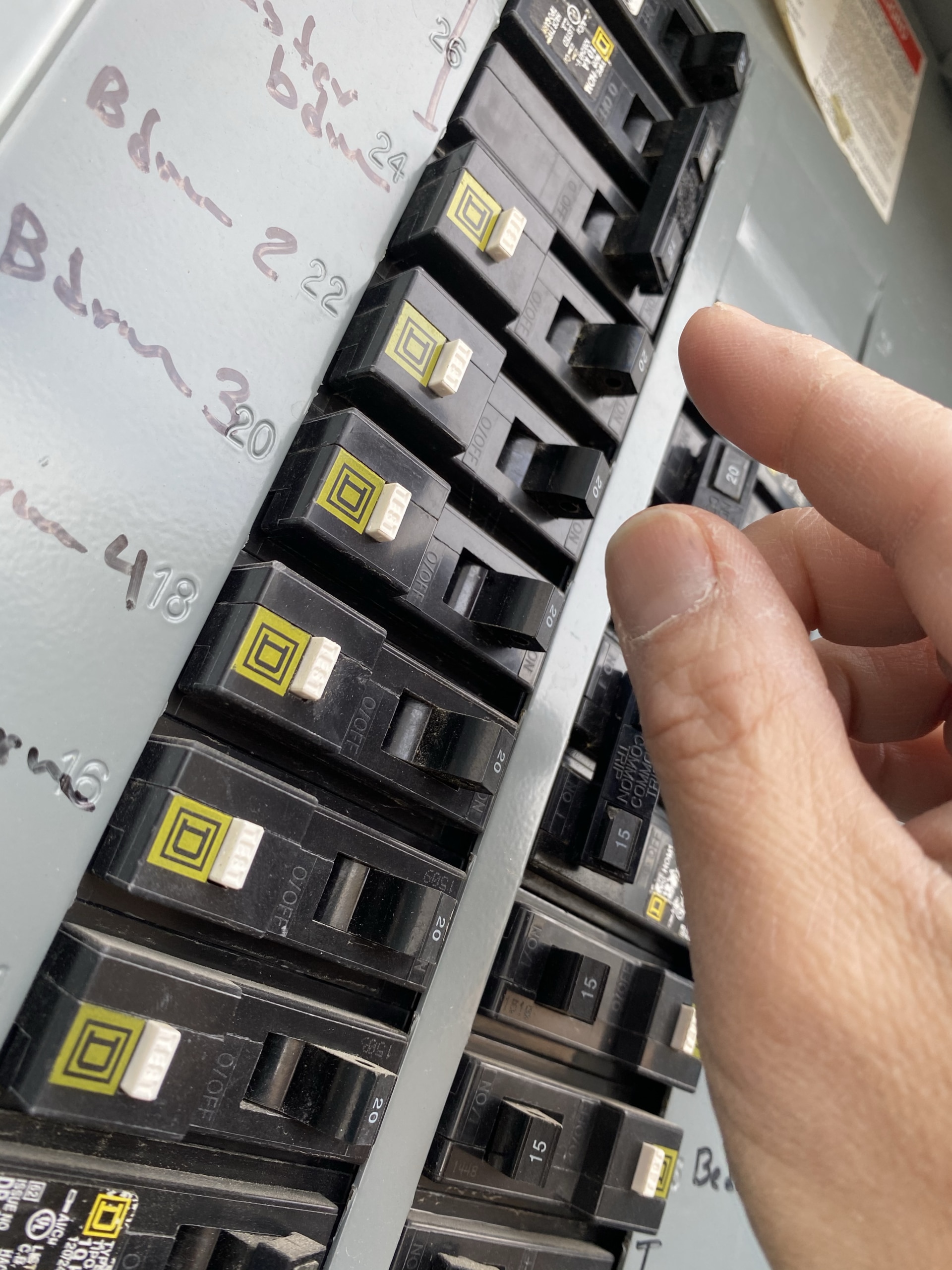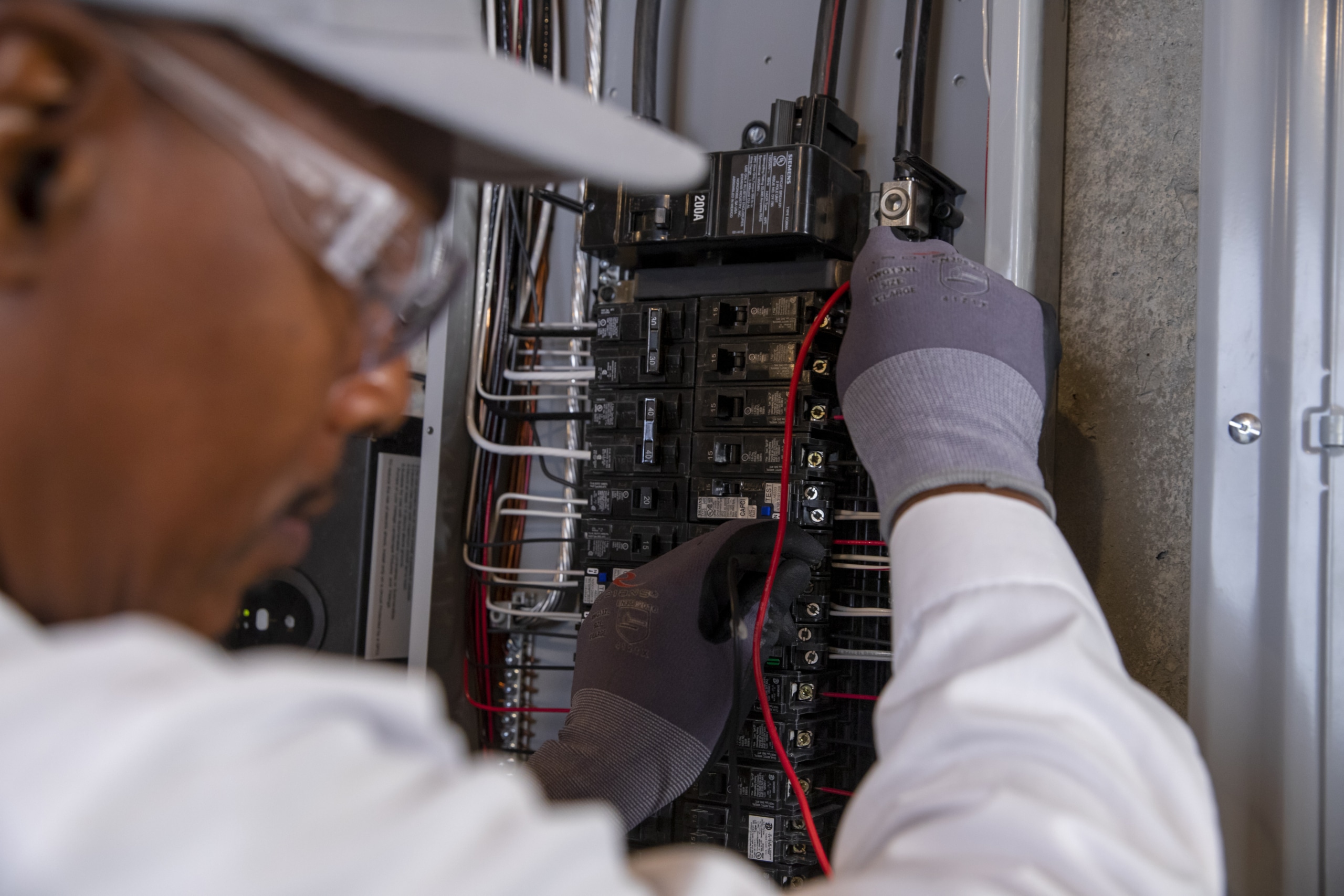Knowing your electrical panel’s ins and outs (like circuit breakers, fuse, lugs, and more) is a great place to start familiarizing yourself with a new home. It can be a saving grace when a breaker trips or when a short circuit occurs and causes a power outage in your home. This will also ensure that what is labeled on your panel is accurate.
Table of Contents
- What Is An Electrical Panel And Why Is It Important?
- Inside The Electrical Panel: A Breakdown Of Key Components
- How Does An Electric Panel Work?
- Types Of Electrical Panels And Common Sizes
- Signs You May Need Electric Panel Service
- When Is It Time To Upgrade Your Electrical Panel?
- Common Problems And Troubleshooting Tips For Your Electrical Panel
- Electrical Panel Codes And Regulations
- FAQs
What Is An Electrical Panel And Why Is It Important?

It is the power center of your home, distributing 200 amps or more throughout your house to all of the electrical outlets, appliances, and devices you use every day.
Electrical panels can usually be found built into the wall of your basement or garage. It is a metal box with a door that opens to a number of switches (circuit breakers) or fuses. These perform the second most important function of an electrical panel by shutting off in the case of short circuits or overloading to avoid a fire hazard. In other words, they help power and protect your home.
Inside The Electrical Panel: A Breakdown Of Key Components
Once you open the outer panel door of your electrical panel, you will find the following components. Knowing these parts of your home’s power distribution center will help keep you safe, avoid fire hazards and electrocution, and understand your home’s electrical limitations.
- Main breaker: will indicate the amperage capacity (ex: 200 amp) for your electrical panel and protects the circuits inside by limiting or cutting off the electricity it receives
- Circuit breakers: switches that control the power to specific areas of your home and turn off if overloaded or short circuited. Several types include single pole, double pole, AFCI, Combination Arc Fault Circuit Interrupters (CAFCI), GFCI, and Dual Function (C/AFCI and GFCI) breakers.
- Protective Cover or Dead Front Cover: a separate cover or door to protect you from the live wires (usually black or red) connected to the circuit breakers
- Bus Bars: Two thick black wires that carry power to the circuit breakers.
- Neutral Bus Bars: Connect to the main neutral wire, which is usually white (and possibly the grounding wire) that carries power back to the panel and completes the electrical circuit.
- Ground Bus Bars: All grounding wires (usually green or bare copper) meet here and provide alternate routes for the current if needed and direct the electricity into the ground to minimize the chances of electric shock or fire.
- Lugs: Metal pieces on wires. Do not touch even when the main breaker is off; they are still electrified and can be fatal.
Once you understand the parts, you may also realize that any electrical work is best left to the professionals who have the training and experience to get the job done correctly, quickly, and safely. Plus, a professional electrician knows the electrical codes and can get any necessary permits to do larger projects or upgrades. This will save you time, energy, money, and damage.
How Does An Electric Panel Work?

Electrical panels receive electricity from your meter, then distribute it to the individual circuits to power your home’s lighting, appliances, and devices. Each circuit breaker controls one room, area, or major appliance of your house and has a set limit of the power load it can carry (15 to 30 amps typically or 120-240 volts, depending on if it is powering lights and TVs or major appliances like ACs or fridges). If one of those areas is overtaxed with electrical current, the circuit breakers will trip (You will notice the switch is flipped between the On and Off settings).
The same will happen if a hot wire touches a neutral wire and causes a power surge, which results in a short circuit. In both scenarios, the circuit breakers function as fail safes. They cut off the power to avoid a fire hazard. To reset your breaker, switch it Off, then turn it back On, and you should be ready. If you have an older home with a fuse box still, you must replace the fuse and consider upgrading your electrical panel to account for the bigger electrical load of the modern home, bring it up to code, and make your home safer.
Types Of Electrical Panels And Common Sizes
Now that you know more about electrical panels, their parts, and how they work, you should know that there are several types of electrical panels in various sizes. For instance, there is the main breaker panel that has a breaker that can turn off all the power in your home. Other types of panels include:
- Fuse Panels are one of the most common types. Fuses must be replaced when an overload occurs.
- Main Lug Panels have wires that connect to the lugs with a separate disconnect that can be shut off at the meter, which is especially handy for firefighters who need to cut the power without or before going into a home.
- Sub-panels are great for garages, workshops, she-sheds, and other areas that need multiple circuits but can still be powered by the main panel.
- Transfer Switches help switch your power from its main source to a backup generator in the event of a storm-caused power outage.
Common design features of electrical panels
- Indoor or outdoor cabinet.
- Water and Dust Protection Index (IPxx).
- Cabinet Certifications.
Types of electrical panels according to their installation
- Built-in cabinets: They are used inside walls or structures.
- Surface cabinet: They are supported on different surfaces.
- Mural Cupboard: They are hung or placed on the walls.
Electrical panels can also vary depending on what they are going to be used for, so the application matters to determine the right size, installation, and technical requirements. These requirements will differ, whether it will be a cabinet panel for a house, a pool, or a specific industry. As far as sizes go, electrical panels can range from 100 amps to 400 amps, depending on the size and/or the amperage needs of the property.
- 100 amps: The average home has 100 amps, but this may be too little for most households.
- 150 amps: A home that runs multiple appliances at the same time will need 150 amps of electricity in an electrical panel.
- 200 amps: A home with heavier energy demands or a house that is nearly 2,000 square feet in size may need 200 amps.
- 400 amps: Large homes that have high-energy needs, or properties with added workshops or outbuildings, will typically require 400 amps to run smoothly.
Signs You May Need Electric Panel Service
Electrical panels need maintenance checks and repairs just like any other system or appliance in your home. However, you should call an electrician to check your electrical panel right away if you notice any of the following:

- Burning smell near the electrical panel (Urgent: turn off the power and call for an electrician immediately).
- Breakers tripping frequently is a sign of overloading or a bad breaker.
- A loose circuit breaker switch means you need to replace it.
- Power surges
- An old, outdated, or broken panel
- Flickering or dimming lights
- Warm, smoking, rusted, or discolored panel
- Strange or crackling noises
- Burn marks or melted wires
- Not enough outlets
- Turning off one appliance to use another
These signs indicate that, at the very least, you need a repair and, at most, to replace your electrical panel for the safety of your home and everything in it or to sufficiently supply the electrical demands of your home. You want to avoid becoming one of the U.S. Fire Administration’s statistics, such as one of 24,200 residential fires caused by electrical malfunctions in 2021.[1]
When Is It Time To Upgrade Your Electrical Panel?
It is typically time to consider upgrading your electrical panel – or adding a sub-panel – if you have reached capacity or have an outdated panel (like a fuse box). You can check your electrical panel to find the amperage capacity for your home and know that most modern homes need 200+ amps to power everything in them, from TVs and appliances to all of their gadgets and toys.
The good things that come from an upgrade include:
- Increasing the value of your home.
- Potentially lowering your insurance premium.
- Getting your money’s worth out of the new electrical panel while you have it.
The challenge is that your electrical needs could change dramatically in that time due to the number of people living in your home and technological advances. A licensed electrician can help you determine the proper load calculation for your home to ensure you get the right panel to fit your electrical needs.
Common Problems And Troubleshooting Tips For Your Electrical Panel
Homeowners will inevitably come across some electrical issue – big or small – after the closing date of their new (or new-to-them) home. Here are some common problems you may experience and how to troubleshoot them.
- Corrosion caused by water or moisture will weaken connections, damage wires, and create a fire hazard. If it is only on the door, sand, prime, and repaint it. If it is inside the panel on the circuit breakers, that is a grave issue. Call an electrician!
- Overload/Tripped Breaker: Even though your circuit may be marked as 15 or 20 amps, it can only manage about 80% of that load. When you connect too many appliances to a circuit, it can overload it. Turn that switch off, then on to bring the power back. Then try another area with less energy-hungry appliances to avoid an overload and a tripped breaker.
- Frequently Tripped Breaker(s): Consider a subpanel or a higher capacity panel if yours is old or outdated.
- Critters Causing Short Circuits: Sometimes, mice or other critters can damage your wires. A good test is to reset your tripped breaker; if it trips immediately, you probably have a short circuit in your hands and need an electrician.
- Device Causing Short Circuits: Check your power cord and outlet for damage. Unplug the device and reset your breaker. If it trips again when you plug it in next, it is the device.
- Crossed Wires Causing Short Circuits: Do not mess with this one on your own; call an electrician!
Call an electrician if you are experiencing any of these or another issue and you cannot figure out the cause or are not comfortable troubleshooting. You can describe the situation, show them the trouble area, and they will identify the cause and diagnose the issue, then present you with your options to fix it.
Electrical Panel Codes And Regulations
You do not have to know the ins and outs of the electric codes and regulations. You just need to be aware that they exist and know a reputable electrician to call to make sure your home follows them and is safe. It is their job to be aware of these codes, standards, regulations, and any permits that may be needed to complete electrical work on your home or property. Two pieces of information that are helpful are knowing:
- Homeowners insurance may require a minimum amperage to get a lower rate.
- The National Electric Code requires “a clear space at least 30 inches wide and 36 inches deep if the equipment is likely to be worked on while energized.”[2]
Electrical Panel: Frequently Asked Questions
A circuit breaker will automatically trip or turn off the power to protect the system from damage and you from shock or fire. It can be switched back on with minimal fuss. A fuse is often found in older homes’ electrical panels called fuse boxes. A fuse will blow and must be replaced to get the power on again.
A main breaker can turn off the power to your house with one switch. A branch circuit breaker only controls the power for one room, area, or major appliance in your home.
If there is any question about the safety of your electrical panel or power in general, turn it off and call an electrician. Also, know that permits and a licensed electrician may be required (nationally and locally) for certain work completed on your electrical system.
It is recommended that you get your electrical panel inspected and maintained every three years.
Smart panels are more expensive than traditional panels. However, they can help optimize energy savings and be more environmentally friendly by being a battery backup system rather than relying on fossil fuels.
It could be time for an upgrade, or you could overload a particular circuit in your home. Unplug some things. If it trips again without them, there is another issue at play. If not, you were overtaxing that circuit.



